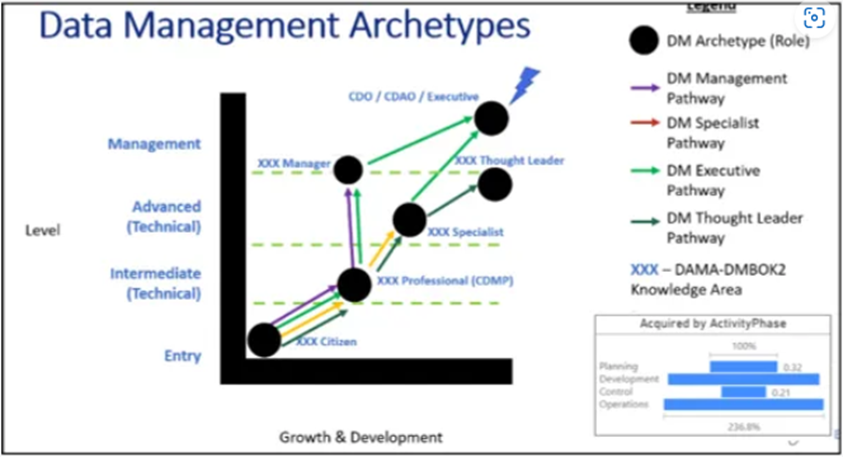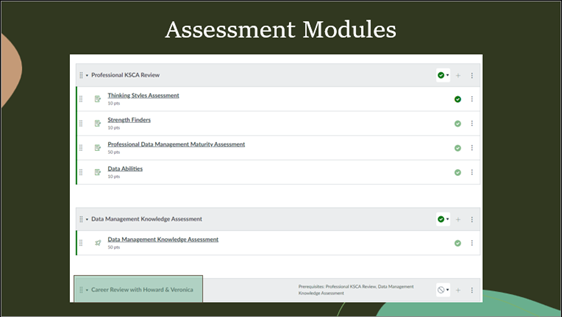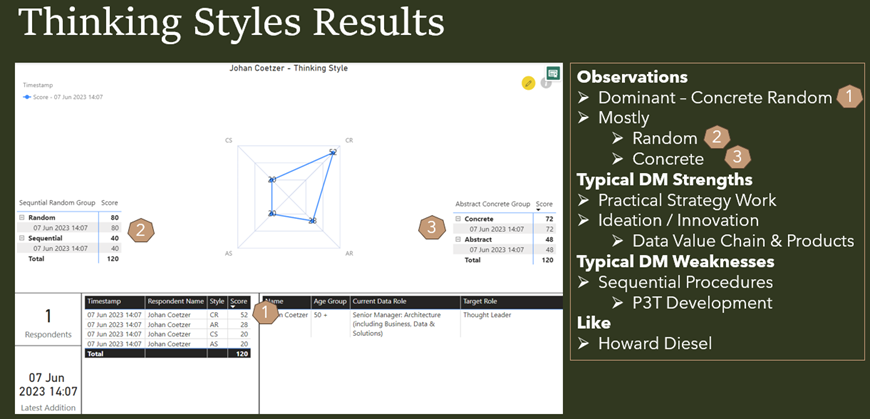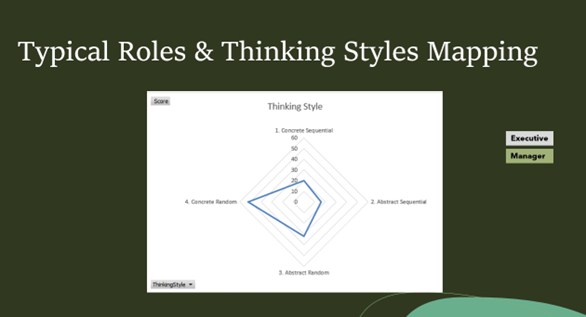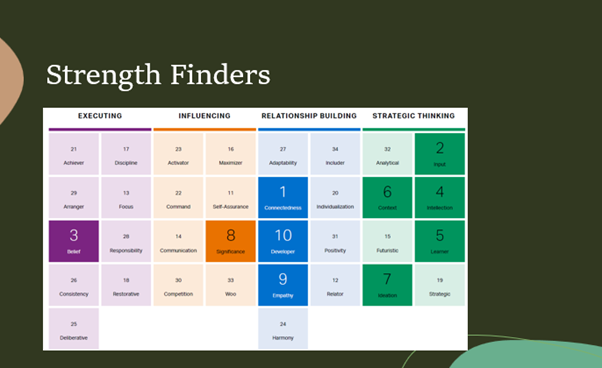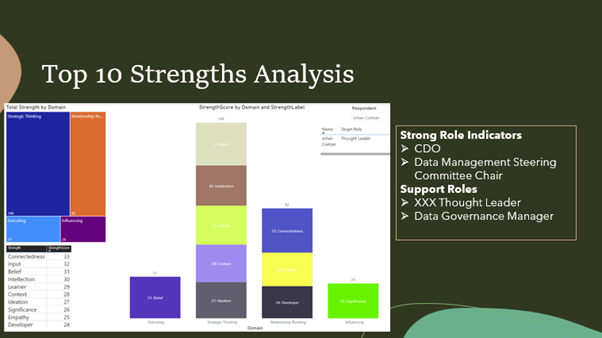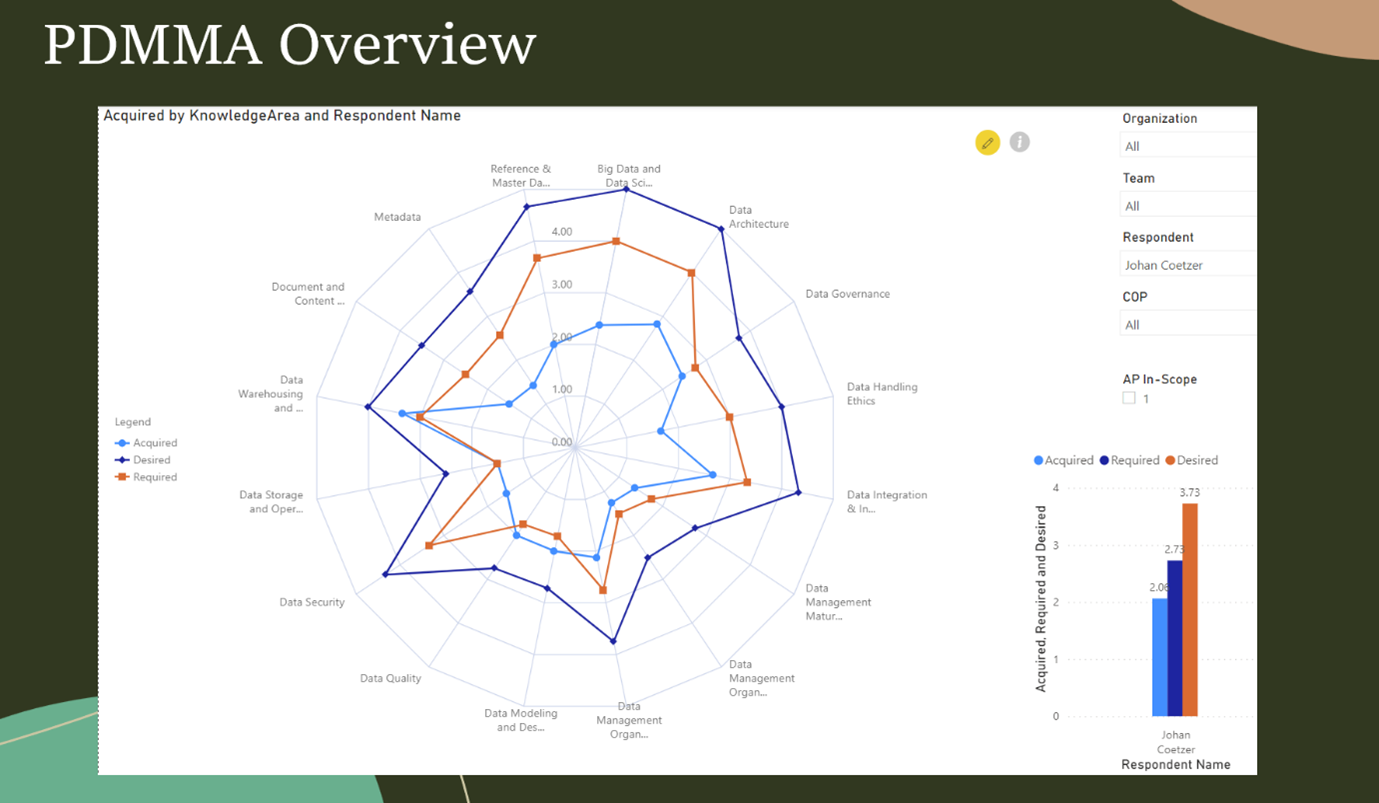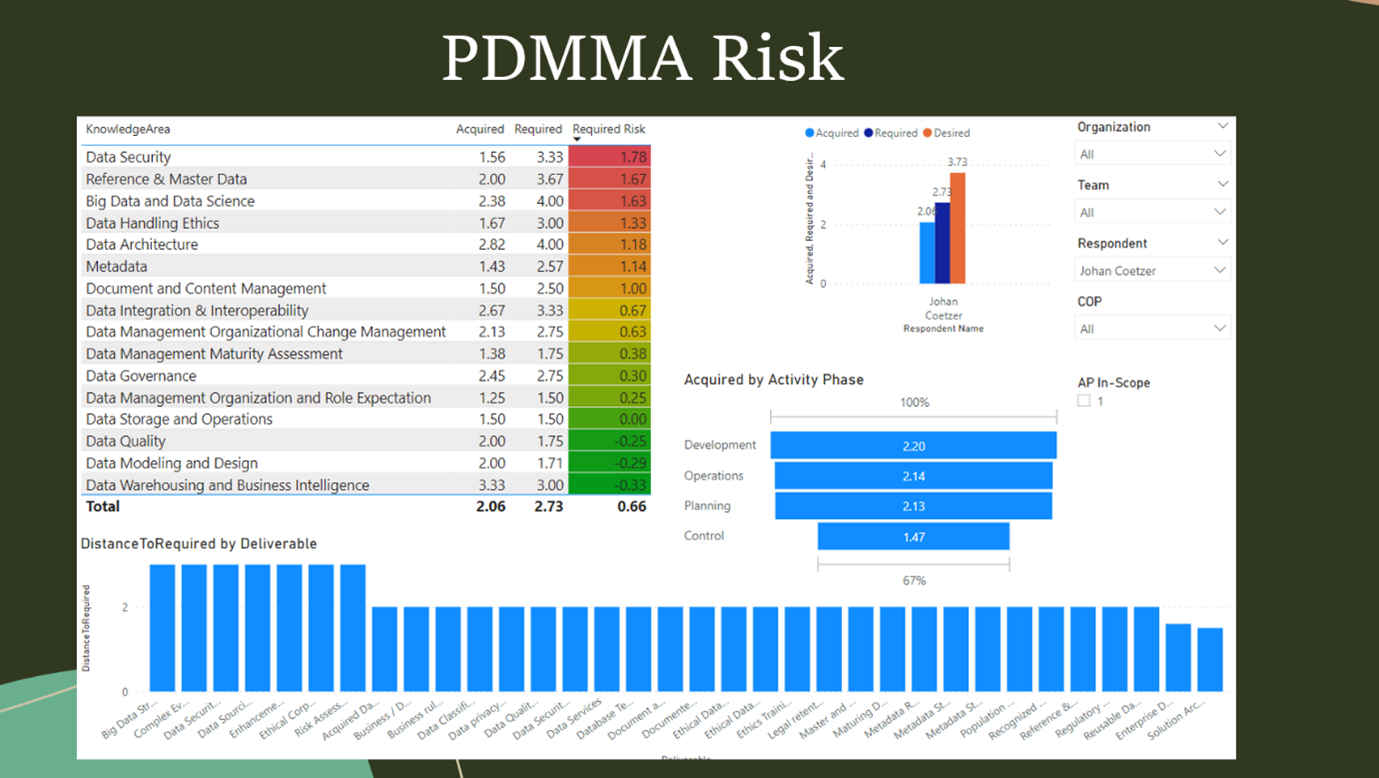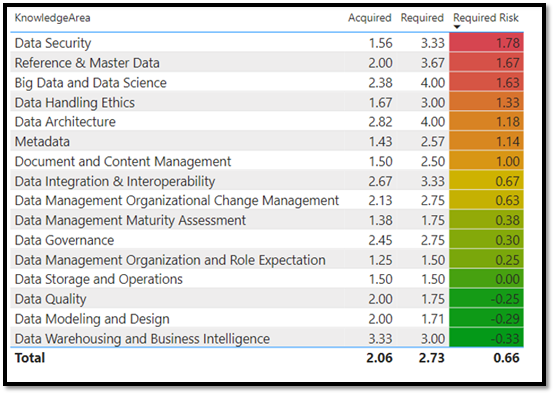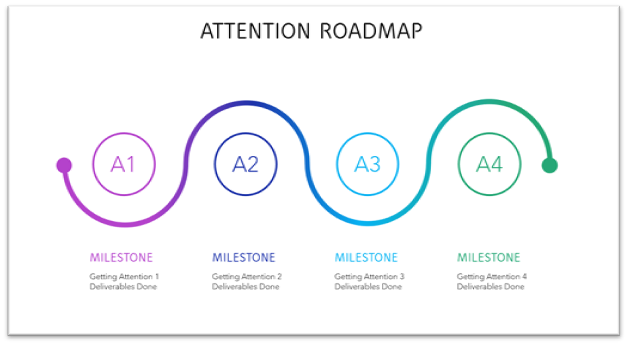Data Career Strategy Development
Executive Summary
This is an overview of the Data Career Strategy and Knowledge Assessment. The assessment measures an uplift in data competency and helps individuals understand their thinking styles and work habits. The evaluation also explores the differences between concrete sequential and random personalities. In summary, understanding thinking styles is crucial for better team dynamics.
Additionally, the assessment analyses CliftonStrengths results and advises CDOs on complementing their team members' strengths. Understanding the development life cycle in operations and control is essential for prioritising options for decision-making and data management areas for becoming an influencer. Creating a roadmap for personal progress is also crucial. The assessment emphasises the importance of having a mentor in professional development and recommends certification areas for a candidate choosing a specialisation. Lastly, the review explains the purpose of certain spreadsheets in the knowledge assessment.
Webinar Details
Title: Data Career Strategy Development
Date: 22nd June 2023
Presenter: Howard & Veronica Diesel
Meetup Group: African Data Management Community
Write-up Author: Howard Diesel
Contents
Executive Summary
Webinar Details
Overview of Data Career Strategy and Knowledge Assessment
Measuring Uplift in Data Literacy
Understanding Thinking Styles and Work Habits
The Differences Between Concrete Sequential and Random Personalities
Summary of a Conversation on Thinking Style
Understanding Thinking Styles for Better Team Dynamics
Career Path and Comparison to Executives and Managers
Analysis of CliftonStrengths Results
Advice for CDOs on strengths and complementing team members
Understanding CliftonStrengths and Professional Correlations
Importance of CliftonStrengths for Understanding Thinking Styles
Analysis of Professional Career Maturity
Challenges in Data Security and Big Data
Understanding the Development Life Cycle in Operations and Control
Prioritising Options for Decision-making
Prioritising data management areas for influencing
Creating a Roadmap for Personal Progress
Importance of Having a Mentor in Professional Development
Recommended Certification Areas for a Writer Choosing a Specialization
Explanation of Spreadsheet Availability in Knowledge Assessment
Overview of Data Career Strategy and Knowledge Assessment
Greetings! The speaker intended to interview Johan Coetzer but will still provide an overview and is open to answering any questions you may have.
According to the speaker, the Data Management Knowledge Assessment is a course open to the public.
The assessment consists of three elements. The first is the Thinking Styles assessment, which we will review today. The second is the CliftonStrengths, which will cost approximately 800 Rand (the exact price to be confirmed by the speaker). The third element is the Professional DMMA.
Yesterday, the speaker engaged in a discussion with Harrison regarding the Professional DMMA.
Measuring Uplift in Data Literacy
During the presentation, Howard evaluated the progress of data communities and students. He utilised two assessment tests, the Data Abilities Assessment and the Data Management Knowledge Assessment.
However, those who have completed the CDMP or Data Management Fundamentals course are exempted from taking the Data Management Knowledge Assessment. Howard and Veronica analyse the results and provide feedback accordingly.
Furthermore, Howard introduced the concept of the Thinking Style, which measures an individual's learning style. Johan Coetzer's results were used as an example, showcasing a dominant score in Concrete Random.
The Concrete Random and Concrete Sequential thinking styles are crucial in practical data strategy work, use case ideation, innovation, data value chain, and product development. The discussion also delved into the weaknesses in principles, policies, and procedures development, with Paul sharing his own experience.
Nevertheless, the speaker emphasised that having weaknesses in these areas does not imply an inability to perform tasks efficiently.
Understanding Thinking Styles and Work Habits
Paul is experimenting to determine the significance of planning the day and completing tasks during the times of the day that are your high-energy daily periods. Strengths refer to activities that boost a person's energy, while weaknesses deplete it. Veronica seeks clarity on the definitions of "random" and "sequential" from Gregorc's Thinking Styles. The terms "abstract" and "concrete" pertain to how individuals take in information through their five senses, while "random" and "sequential" refer to how they organise it. Sequential individuals prefer working systematically from the beginning, whereas random individuals prefer multitasking and jumping between tasks. A person's natural thinking style may impact their work habits, but they can still adjust their practices based on the situation and task.
The Differences Between Concrete Sequential and Random Personalities
People with random personalities tend to be natural problem solvers who enjoy experimenting and taking risks. They have a unique ability to see things from different angles and envision new ways of doing things. Instead of shying away from risks, they get excited by them and view mistakes as learning opportunities. These qualities make them excellent entrepreneurs and leaders in the business world.
On the other hand, sequential personalities are more rooted in reality and tend to follow a linear approach when studying a topic. They prefer to cover all the material before moving on to tests or applying the information. They thrive in organised environments where tasks are presented in a structured manner.
When it comes to learning, random personalities tend to use a DIY approach, incorporating active learning and quizzes to help them dive deeper into areas they need to work on. They are also highly considerate of others and prioritise the feelings of their team members.
Concrete sequential personalities have a strong need for order and structure daily. They become unhappy when things are disorganised or out of place and prefer to have all their "ducks in a row."
Summary of a Conversation on Thinking Style
Our conversation revolves around the impact of thinking styles on work performance.
We began by discussing the abstract random thinking style, commonly preferred by individuals with an unstructured approach to work who prioritise team harmony. They tend to contemplate ideas internally and avoid trial and error.
Next, we explored the concrete sequential thinking style used by research scientists and philosophers who follow the scientific method. They tend to work methodically and prefer working independently.
Our conversation then shifted towards Johan, who possesses a concrete random thinking style. This means he enjoys experimentation and intuitive leaps and constantly seeks new challenges.
Johan's thinking style suits practical strategy development, ideation, innovation, and building data value chains and products.
Understanding Thinking Styles for Better Team Dynamics
When embarking on a career, it's crucial to comprehend one's thinking patterns since they tend to fluctuate frequently. An assessment of Johan’s thinking style reveals his preferred thought leadership over management.
Compared to Howard, Johan exhibits less concrete sequential thinking and more abstract sequential thinking.
When assembling a team, it's beneficial to seek out individuals who promote abstract sequential and abstract random thinking. It's also vital to maintain a balance of team dynamics.
An example of an effective management style is open planning, where the leader operates in the centre of the team and welcomes interruptions, diverse ideas and perspectives.
Career Path and Comparison to Executives and Managers
Let's talk about career paths and the decisions that come with them, such as where to start and how to choose. You might be weighing the pros and cons of working for specialised disruptor organisations versus larger consulting firms like KPMG or PWC. It's crucial to regularly reevaluate and adjust your career path as needed. You can also compare your thinking style and strengths to those of executives and managers.
Additionally, you may be interested in learning about CDO and EIM manager levels. EIM managers should have well-defined procedures, processes, roles, and responsibilities. If you want to explore more about thinking styles, you can check out Veronica's link and QR code. Lastly, I welcome any questions or comments from the audience.
Use this QR code to learn more about Thinking Styles
Analysis of CliftonStrengths Results
The CliftonStrengths assessment was introduced as a complement to the thinking styles assessment. Johan's results from the CliftonStrengths test indicate a strong execution ability, with high levels of belief and dominance in strategic thinking and relationship building. One of the identified strengths is Connectedness, along with other areas like WOO. However, Johan's lowest scoring area is Influencing, suggesting a more suitable role as a CDO rather than a thought leader.
To improve in “influencing,” working on self-assurance, communication, competition, command, and activation skills is recommended. Johan has strong strategic thinking and relationship-building capabilities, but further development in influencing abilities is necessary to achieve better results.
Advice for CDOS on strengths and complementing team members
Having exceptional skills in winning people over is crucial for a Chief Data Officer (CDO) to gain support and successfully transform the business. CDOs must focus on developing their abilities to build relationships and form coalitions. They create guiding coalition teams through strategic planning and building connections with others. Typically, CDOs operate at the executive level rather than as thought leaders.
To enhance their strengths, CDOs should seek out thought leaders and management professionals to help them keep things organised. Someone naturally skilled at building relationships and collaborating could benefit from implementing strategies to spread influence throughout the organisation and the community.
Understanding CliftonStrengths and Professional Correlations
For those pursuing a career as a thought leader, honing communication skills and identifying areas of expertise is crucial. Building a team with complementary skills is also essential for success in this field. CliftonStrengths is a valuable resource for determining one's strengths and areas for improvement, which can be used to develop professional skills. It is recommended to start by examining the top ten strengths to understand individual strengths and weaknesses better. Additionally, analysing data with Power BI can help identify correlations and trends in professional skills, offering valuable insight for career development and improvement.
Importance of CliftonStrengths for Understanding Thinking Styles
During the discussion, Howard suggested combining CliftonStrengths and Thinking Styles can lead to a more comprehensive understanding of relationships and effective communication. Paul made sure to redo his CliftonStrengths assessment to ensure he was honest with himself, and he encouraged others to do the same to identify their strengths and strive for success. While trying new things can sometimes lead to setbacks, it also presents opportunities for personal growth. Howard struggled with determining if “influence” was a reliable indicator of strategic alignment or just a result of chance. However, using CliftonStrengths can help individuals feel reassured that they are on the right path and is highly beneficial.
Analysis of Professional Career Maturity
During the conversation between Paul and Howard, it became apparent that a clear roadmap is essential to achieve career goals. Johan completed a Personal Data Maturity Assessment to evaluate his skills and knowledge in different areas. The research used orange to indicate the required skills for Johan's current role while also considering his acquired skills. It was revealed that Johan needs to improve in Document and Content, Metadata, Data Handling Ethics, and the Data Management Maturity Assessment. A suggested approach to help Johan achieve his career goals effectively would be prioritising the areas with a gap of two between required and acquired skills.
Challenges in Data Security and Big Data
The individual speaking is an expert in high-risk data security and big data, but due to a series of short-term assignments, they have yet to understand these areas thoroughly. The accompanying diagram indicates a ratio of distance to requirement, highlighting the gaps in knowledge between what is required and what has been acquired in various areas, such as data security and big data strategy. Johan identifies data security strategy, complex event processing, data sourcing, and ethical risk assessment as his most significant challenges. Howard recognises the importance of being selective about projects and focusing on areas that require in-depth knowledge.
Understanding the Development Life Cycle in Operations and Control
During the talk, Howard discussed the development life cycle, which includes development, operations, planning, and control. He highlighted his own expertise in the operations aspect. To illustrate how filtering can reveal specific tasks, they used Power BI as an example. Howard suggested that graduates and professionals should communicate to management the difference between required and desired tasks, aligning them with the organisation’s talent strategy.
He referred to control as "Assurance," which involves overseeing, containing, and reviewing data models and other strategies. Architects typically handle Assurance, but he acknowledged the challenge of doing so with short-term projects. Experience is crucial in determining one's priorities and menu of options.
Prioritising options for decision-making
Johan suggested using a risk score to evaluate the available options when making decisions. To prioritise high deliverables, an attention score is applied. Organisational priorities and desired areas, such as Big Data strategy, data sourcing plan, and complex event processing, are considered. Ranking exercises are conducted to assign importance to different knowledge areas, with data security and content integration being given high priority. Data modelling is frequently outsourced to specialists, whereas storage and operations are considered lower-priority options.
Prioritising data management areas for influencing
According to Howard, Big Data is currently at level three, which they believe is lower than its true potential. To fully realise “datability,” Howard suggested adding deliverables. Johan's areas of “influence” included Ethics, Metadata, Data Architecture, Integration and Interoperability, and Big Data and Data Science. Howard recommended lowering original to level three. The audience is encouraged to create a roadmap when choosing or changing their options.
Howard highlighted attention areas such as complex event processing, data security, enterprise data models, ethical risk assessments, and business rules. By restructuring the desired attention areas, a different picture of the areas that require attention can be obtained.
Creating a Roadmap for Personal Progress
Combining thinking styles with CliftonStrengths analysis results can offer valuable insights for personal growth. It's important to prioritise goals using attention data and establish milestones for different aspects of development, such as presentations and webinars (A1, A2, and A3). Keeping track of skills, certifications, competencies, and abilities in a spreadsheet can provide visual representation during team meetings or interviews. Lastly, it's crucial to understand one's mental menus and memory and track progress for effective personal development.
Importance of Having a Mentor in Professional Development
Howard highlighted the significance of having a mentor for professionals to validate their skills and realign their career path. A mentor offers objective insights and assists in strategising one's career path. Having someone to confide in and process information gathered from career assessments is essential to successful practice. Additionally, Howard stressed the importance of building a portfolio and establishing oneself as a thought leader in a specific field. Successful professional development requires prioritising skills and personalising one's career path.
Recommended Certification Areas for a Professional Choosing a Specialization
Johan’s interest lies in ensuring data privacy and security are upheld with ethical and proper governance. Howard recommended that Johan concentrates on Data Architecture, Governance, and Data Security and Data Privacy. To further advance his skills in the field, Howard suggested international certification programs such as ISO 27 000, IAPP, DDPSE, AML, or COBIT. He then emphasised the importance of prioritising one key area to focus on. To establish himself as “a thought leader,” Howard advised Johan to share his knowledge through blogging and speaking engagements. Additionally, a mentor would guide a professional in finding opportunities to sell services related to their chosen specialisation.
Explanation of Spreadsheet Availability in Knowledge Assessment
As the session gets late and some participants have dropped off, Howard paused to ask if anyone has any comments or questions. Dumisani inquired about consultations for the spreadsheet and is informed that it can be downloaded during the knowledge assessment. Dumisani confirmed that the knowledge assessment is the Google form directed by Howard to the professional DMMA page where the spreadsheet can be downloaded.
Howard guided Dumisani on accessing the reference data for the entries. It is confirmed that the spreadsheet is available through the professional DMMA Course and can be worked on independently. The writer concludes the session by expressing gratitude for everyone's participation and acknowledging the pressure of the first live career interview.
Tracking Data Quality KSCA (Knowledge, Skills, Competencies, and Attitude) progress using a Data Management Maturity Assessment
If you would like an assessment done for you and/or your team, please reach out to us. We are excited to start this exciting journey with you!
If you want to receive the recording, kindly contact Debbie (social@modelwaresystems.com)
Don’t forget to join our exciting LinkedIn and Meetup data communities to not miss out!

